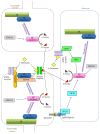D-Amino Acids in the Nervous and Endocrine Systems
- PMID: 28053803
- PMCID: PMC5178360
- DOI: 10.1155/2016/6494621
D-Amino Acids in the Nervous and Endocrine Systems
Abstract
Amino acids are important components for peptides and proteins and act as signal transmitters. Only L-amino acids have been considered necessary in mammals, including humans. However, diverse D-amino acids, such as D-serine, D-aspartate, D-alanine, and D-cysteine, are found in mammals. Physiological roles of these D-amino acids not only in the nervous system but also in the endocrine system are being gradually revealed. N-Methyl-D-aspartate (NMDA) receptors are associated with learning and memory. D-Serine, D-aspartate, and D-alanine can all bind to NMDA receptors. H2S generated from D-cysteine reduces disulfide bonds in receptors and potentiates their activity. Aberrant receptor activity is related to diseases of the central nervous system (CNS), such as Alzheimer's disease, amyotrophic lateral sclerosis, and schizophrenia. Furthermore, D-amino acids are detected in parts of the endocrine system, such as the pineal gland, hypothalamus, pituitary gland, pancreas, adrenal gland, and testis. D-Aspartate is being investigated for the regulation of hormone release from various endocrine organs. Here we focused on recent findings regarding the synthesis and physiological functions of D-amino acids in the nervous and endocrine systems.
Conflict of interest statement
The authors declare that they have no competing interests.
Figures


References
-
- Meldrum B. S. Glutamate as a neurotransmitter in the brain: review of physiology and pathology. Journal of Nutrition. 2000;130(4):1007S–1015S. - PubMed
Publication types
LinkOut - more resources
Full Text Sources
Other Literature Sources

